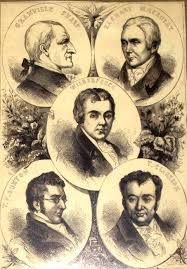The Clapham Sect or Clapham Saints were a group of Church of England social reformers based in Clapham, London at the beginning of the 19th century (active c. 1790–1830). They are described by the historian Stephen Tomkins as “a network of friends and families in England, with William Wilberforce as its centre of gravity, who were powerfully bound together by their shared moral and spiritual values, by their religious mission and social activism, by their love for each other, and by marriage”.
Campaigns and successes
Its members were chiefly prominent and wealthy evangelical Anglicans who shared common political views concerning the liberation of slaves, the abolition of the slave trade and the reform of the penal system.
The group’s name originates from those attending Holy Trinity Church on Clapham Common, an area south-west of London then surrounded by fashionable villas. Henry Venn the founder was curate at Holy Trinity (1754) and his son John became rector (1792-1813). Wilberforce and Thornton, two of the group’s most influential leaders, resided nearby and many of the meetings were held in their houses. They were supported by Beilby Porteus, Bishop of London, who sympathised with many of their aims. The term “Clapham Sect” was a later invention by James Stephen in an article of 1844 which celebrated and romanticised the work of these reformers. In their own time the group used no particular name, but they were lampooned by outsiders as “the saints”.
The group published a journal, the Christian Observer, edited by Zachary Macaulay and were also credited with the foundation of several missionary and tract societies, including the British and Foreign Bible Society and the Church Missionary Society.
They founded Freetown in Sierra Leone, the first major British colony in Africa, whose purpose in Thomas Clarkson’s words was “the abolition of the slave trade, the civilisation of Africa, and the introduction of the gospel there”.
After many decades of work both in British society and in Parliament, the group saw their efforts rewarded with the final passage of the Slave Trade Act in 1807, banning the trade throughout the British Empire and, after many further years of campaigning, the total emancipation of British slaves with the passing of the Slavery Abolition Act in 1833. They also campaigned vigorously for Britain to use its influence to eradicate slavery throughout the world.
Other societies that they founded or were involved with included the Anti-Slavery Society, the Abolition Society, the Proclamation Society, the Sunday School Society, the Bettering Society, and the Small Debt Society.
The Clapham Sect have been credited with playing a significant part in the development of Victorian morality, through their writings, their societies, their influence in Parliament and their example in philanthropy and moral campaigns, especially against slavery. In the words of Tomkins, “The ethos of Clapham became the spirit of the age.”
Members
Members of the Clapham Sect included:
- Thomas Fowell Buxton (1786–1845), MP and brewer
- William Dealtry (1775–1847), Rector of Clapham, mathematician
- Edward James Eliot (1758–97), parliamentarian
- Thomas Gisbourne (1758–1846), cleric and author
- Charles Grant (1746–1823), administrator, chairman of the directors of the British East India Company, father of the first Lord Glenelg
- Katherine Hankey (1834–1911), evangelist
- Zachary Macaulay (1768–1838), estate manager, colonial governor, father of Thomas Babington Macaulay
- Hannah More (1745–1833), writer and philanthropist
- Granville Sharp (1735–1813), scholar and administrator
- Charles Simeon (1759–1836), Anglican cleric, promoter of missions
- James Stephen (1758–1832), Master of Chancery, great-grandfather of Virginia Woolf.
- Lord Teignmouth (1751–1834), Governor-General of India
- Henry Thornton (1760–1815), economist, banker, philanthropist, MP for Southwark, great-grandfather of writer M. Forster
- Henry Venn (1725–97), founder of the group, father of John Venn (1759–1813) and great-grandfather of John Venn (originator of the Venn diagram)
- John Venn (1759-1813), Rector of Holy Trinity Church, Clapham
- William Wilberforce (1759–1833), MP successively for Kingston upon Hull, Yorkshire and Bramber, leading abolitionist
- William Smith (1756-1835), MP.





Fascinating! Thanks Stuart.
LikeLiked by 1 person
Ah thanks. Yes it is. Amazing how many were older relatives of The Bloomsbury Group too x
LikeLiked by 1 person
That struck me too! xx
LikeLike
Reblogged this on First Night History and commented:
This is of particular interest to me as William Wilberforce is an ancestor of mine.
LikeLiked by 1 person
Thomas Gisbourne (sic.) is an ancestor of mine. Very proud of him! (The family name is actually Gisborne without the ‘u’ …)
LikeLiked by 2 people
Wow that’s fascinating how lucky to have that claim to fame
LikeLike
Well, I’m very pleased about it. The Gisbornes were the maternal branch of my mother’s family, and they seem to have been pretty good philanthropists most of the time. At any rate, they had a bit of a social conscience, although they were quite impoverished, and married money at the drop of a hat! Thanks for liking and accepting. Keep up the good work.
LikeLiked by 1 person